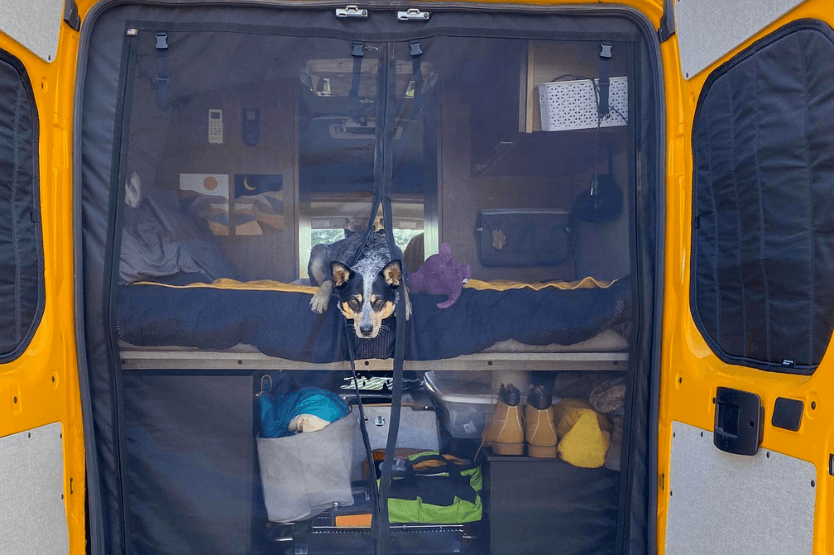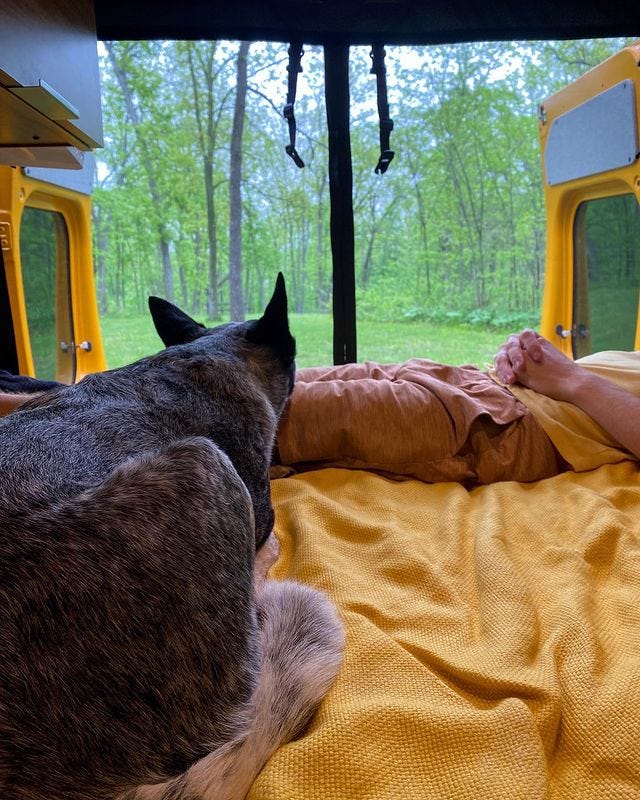It’s officially been more than five months since we moved into our converted Ram Promaster, Hermes, full time. Our home-on-wheels is bright yellow on the outside, cozy on the inside, and easily the best place I’ve ever lived. He’s also pushed us in all the ways you might expect (hello scary new experiences) and some I didn’t know to anticipate.
Here are the top things I’d go back in time and tell myself before we hit the road.
We could have packed even fewer belongings
I’ve been (pleasantly) surprised at how few material items we actually need for day-to-day comfort.
Sean and I have leaned minimalist for a while—it’s long been a joke that our cattle dog Scout might have more belongings than we humans do—but we still downsized considerably to move into Hermes. We pared our wardrobes and took a half dozen trips to different local donation centers before organizing our remaining things in the van.
And then we ended up downsizing even more.
A few items we thought we’d use that we ultimately got rid of
Several of Scout’s toys. She’s quite happy to play with whatever stick we find a camping spot, and a small handful of versatile things (like her puller ring that’s great for both fetch and tug) get the job done.
My yoga mat. I usually end up just using our Rumpl camp blanket for ground workouts and stretching.
Plates. It’s easy to eat most things out of bowls or assemble a sandwich right on the cutting board.
Our pizza cutter. We don’t have an oven, so we don’t make pizza—and when we do make quesadillas or similar meals, regular knives work just fine.
A slew of other dishes. When you hand wash things often and only ever feed two people (and one dog) at a time, it’s surprising how few things you need. Three bowls, two mugs, one regular glass, two tupperwares, some pots & pans… The list feels pretty short now but to be honest, we probably still have more utensils than we actually need.
Extra organization totes. We initially had our toolkit, boots, and a few other items in a clear plastic bin in the “garage” area under the bed. We later realized that some things actually fit better loose (we can tuck boots between our lawn chairs, for example) and the tote took up more space rather than less.
Miscellaneous clothes. At first we used all our clothing storage space. If we had room for it, why not bring it? Over time I realized how many things I never really wore, though. We usually go around two weeks between laundromat visits and I still have some clean clothes left by that time, but if I don’t wear something for a month (unless it’s a very season-specific item like a winter jacket or summer dress) I donate it.
And some stuff we couldn’t live without
It still surprises me how short this list is. The absolute non-negotiables we keep on hand include daily toiletries (toothpaste, toothbrushes, floss, retainers, deodorant, sunscreen, my toner, soap) and basic cleaning supplies (mostly a small broom and natural disinfectant wipes). Food too, of course, and medications.
Update: You can read a more comprehensive inventory of the things I always want to have in Hermes here!
You can never understand your electrical system too well
And all the other technical pieces that make your home on wheels function.
While I don’t think you need to be an expert to live on the road—Sean and I (especially me) are still certainly not mechanics or electricians—a solid working knowledge is invaluable when things go wrong.
We could troubleshoot potential causes when we had inverter issues in March and then battery problems in May to give our conversion company more upfront information (and Sean was able to disconnect the batteries himself with help from a few friends, which was huge). We fixed our water pump pressure ourselves. We ultimately feel more confident heading away from civilization knowing that we have at least a few baseline skills to address—or at least recognize—inevitable malfunctions.
My biggest lessons here:
Nothing beats actually opening up all your cabinets and seeing firsthand what things are supposed to look like. How are all the parts connected? That helped me better understand what they all do.
Similar story with revisiting our initial van diagrams. Visualizing how it all fits together has been key for me.
What roads a converted Promaster can and cannot safely drive on
Hermes does not have high clearance or 4WD. But that doesn’t mean we have to stick strictly to pavement! Now that we’re a few months into traveling full time, I feel like Sean and I both have an accurate idea of what roads we’ll be able to handle—and I wish I could go back and important this knowledge, fully formed, into my brain before we started
What determines if we can safely drive somewhere:
Road surface itself. Pavement and gravel are fine. Grass and dirt depend more on the below variables, while sand is pretty much always a no go.
Recent weather conditions. Our van is heavy and easily sinks in mud. If it’s recently rained, we’re a lot more careful about where we go.
Incline. Slightly muddy roads that are flat? Much more doable than hills in the same conditions!
Being acutely aware of resource consumption is transformative
I like to think I’ve been reasonably aware of my environmental impact for a while… but moving into our van showed me some huge holes in my estimates.
Hermes has a composting toilet with a two-gallon pee jug, a seven-gallon gray water tank, and a 30 gallon freshwater tank—and three 12.8 volt lithium ion batteries charged by a second alternator when we drive. At any given moment I need to be at least relatively aware of all these levels!
It’s different from living in a house with constant electricity, an effectively endless water supply, and twice weekly trash pickup. There’s no throwing something in an outdoor bin and forgetting it ever existed. I can’t soak for ten minutes in the shower steam. I’ve never been able to track my liquid intake and output so accurately.
And while it’s challenging sometimes (the only thing I properly miss from living in a house is long showers) it’s also eye opening in the best way. I feel like I’ve never been more thoughtful about what I use and why. I hope I can carry that sense with me even long after we stop living in a van, if that day comes.
There are tons of places to park, fill up with water, and empty tanks
I am an expert worrier. Before we hit the road I was most nervous about finding safe spots to sleep every night (especially without having to pay traditional campground fees all the time) and when I realized we’d need to fill our water tank at least once a week I started panicking about that too.
Thankfully, though? It’s significantly easier to locate the services we need than I imagined! This is due in large part to apps like iOverlander and the ubiquitous nature of online information overall, along with the fact that once you get into the habit of looking for certain things it’s pretty easy to adjust (more on that habituation in the next section).
But it can take some work and experimentation to find them
While sleeping, fueling, and emptying tanks is more convenient than I initially fretted about, it’s important to note it’s not a total walk in the park.
I wish I’d had a better idea of what exactly it would take: on average a couple hours a week scoping out spots ahead of time, patience to try a different location if the first one doesn’t work out (particularly when it comes to filling up water in the winter), a padded budget in case dump stations & other services aren’t free, and an overall willingness to go out of our way to get what we need. (Thankfully the whole nature of living on the road means we’re flexible, so “out of the way” is usually very relative.)
You can habituate to almost anything
Shortly after my college graduation I set off to live in Thailand for a few months at an elephant sanctuary. This was when I first started to understand phrases like “you can do anything for a short time”—and van life has only deepened that.
The biggest surprise I’ve had about living on the road? The thing that caught me off guard the most?
How easy it’s been.
I don’t want to misrepresent that life in Hermes is perfect, or that there aren’t any challenges, or that we love every minute of it (we don’t). But I think I went too far in the direction of “prepare yourself for the worst case scenario” when we were getting ready to move into the van—and it definitely caused some unnecessary stress.
Yes, being a nomad is a lot different than living in a house. It’s great to be aware of how our daily routines might change! But it’s also incredible to realize how resilient we are. That before we know it we’ll be totally adjusted to navigating a small space and working out of parking lots and everything else.
I think a huge part of this habituation is the fact that van life truly is well suited to my and Sean’s personalities (and we did plan for it pretty well). But I also think it’s a testament to the adaptability of humans overall. We can handle a lot more than we think we can, most of the time.
Respect, kindness, and common sense go a long way
It’s no secret that not everyone is fond of van lifers. Many communities, businesses, and park rangers have every right to be wary of this lifestyle—a loud minority gives us all a bad name when they leave behind litter or abuse free services or otherwise cause a ruckus.
But we have the power, at least on a small scale, to help change some of those opinions. Basic considerations like picking up trash at free camping spots, making sure we actually pay when dump stations request it on an honor system, supporting local businesses, and so on can go a long way.
I’ve been pleasantly surprised that most areas welcome us with open arms when we do our part. It’s definitely not all—some communities are effectively impossible to stay in for more than a single night if that—but it’s more than I initially hoped for.







